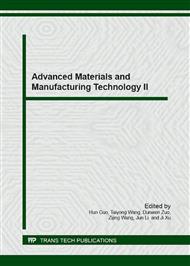[1]
L. Bates,. Problems in particulate flow, Educational Resources for Particle Technology, ERC at the Univ. of Florida. (1999).
Google Scholar
[2]
M.H. Abbaspour-Fard, Numerical simulations to investigate the role of particle shape on bulk behaviour of particles in silos. VIII International Conference on Computational Plasticity, Complas VIII, Barcelona. (2005).
Google Scholar
[3]
Y.J. Li , & Y. Xu , and C. Thornton, A comparison of discrete element simulations and experiments for sandpiles, composed of spherical particles, Powder Technology. 160(3)(2005) 219-228.
DOI: 10.1016/j.powtec.2005.09.002
Google Scholar
[4]
P.W. Cleary, The effect of particle shape on hopper discharge. Second International Conference on CFD in the Minerals and Process Industries, CSIRO, Melbourne, Australia 1999.
Google Scholar
[5]
P.W. Cleary, Recent advances in DEM modelling of tumbling mills. Mineral Engineering. 14 (2001) 10.
Google Scholar
[6]
S.H. Li, L.D. Zhang, X. Zhang, K.S. Yu, Q. Wang, and W.J. Hao, Numerical analysis of particle mixing and movement in rotary retorting, Proceedings of the CSEE. 31(02)(2011) 32-38. (in chinese).
Google Scholar
[7]
H.X. Jin, N. Bai, & G. Yang, The DEM simulation study of the particle mixing process in the rotating cylinder, Control Engineering of China. 20(03)(2013) 566-570. (in chinese).
Google Scholar
[8]
D. Kadau, L. Brendel, G. Battels, D.E. Wolf, M. Morgeneyer and J. Schwedes, Macroscopic and Microscopic Investigation on the History Dependence of the Mechanical Behaviour of Powders, Chemical Engineering Transactions. 3 (2003) 979.
Google Scholar
[9]
R.M. German,. Powder Metallurgy Science, 2nd Ed., Metal Powder Industries Federation, Princeton, New Jersey, (1994).
Google Scholar
[10]
J.C. Williams, The Segregation of Particulate Materials, a Review, Powder Technology. 15 (1976) 245.
Google Scholar
[11]
J. Bridgewater, Fundamental Powder Mixing Mechanisms, Powder Technology. 15 (1976) 215.
Google Scholar
[12]
N. Standish, Studies of Size Segregation in Filling and Emptying of Hopper, Powder Technology. 45 (43) (1985).
DOI: 10.1016/0032-5910(85)85059-2
Google Scholar
[13]
Y. Youm, and T.C. Huang, Exact displacement analysis of XCCC spatial mechanisms by the direction cosine matrix method, Mechanism and machine theory. 25 (1990) 85-96.
DOI: 10.1016/0094-114x(90)90109-w
Google Scholar
[14]
S.H. Jia, Rigid body dynamics, The higher education press . 1987. (in chinese).
Google Scholar
[15]
P. Cundall and O. Strack, Discrete numerical-model for granular assemblies, Geotechnique. 29 (1979)47–65.
DOI: 10.1680/geot.1979.29.1.47
Google Scholar
[16]
H. Hertz, Über die Berührung fester elastischer Körper, J. Reine Angew. Math. 92 (1882).
DOI: 10.1515/9783112342404-004
Google Scholar
[17]
R.D. Mindlin, Compliance of elastic bodies in contact, J. Appl. Mech. -Trans. ASME. 16 (1949) 259–268.
Google Scholar
[18]
Y. Tsuji, T. Tanaka and T. Ishida, Lagrangian numerical simulation of plug flow of cohesionless particles in a horizontal pipe, Powder Technol. 71 (3) (1992) 239–250.
DOI: 10.1016/0032-5910(92)88030-l
Google Scholar


